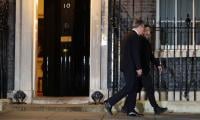The Afghan peace process suffered a setback when the peace talks scheduled for April 24 in Turkey were postponed. The Taliban refused to attend the peace conference. Now the conference might take place in May.
The US-backed peace talks hosted by Turkey, Qatar and the UN were planned so as to resume the peace process between the Afghan government and the Afghan Taliban.
The main purpose of the international conference was to kickstart the stalled peace talks between the Afghan government and the Taliban to bring the peace process on track. US President Joe Biden already announced the withdrawal of US troops from the country by mid-September.
The US administration is keen to install an interim government in Kabul including the Taliban before completing the military withdrawal from Afghanistan. But Afghan President Ashraf Ghani is opposing such a political settlement at the expense of his presidency and government.
The Afghan government does not seem to be happy with the way American officials are exerting pressure to concede to some of the Taliban’s demands. It seems that a deadlock still persists between the different stakeholders. The postponement of the Istanbul conference has raised doubts about the peace process and the intra-Afghan dialogue.
The Afghan peace process and negotiated political settlement is a complex issue. The stakes are high and all sides are weighing their options carefully for maximum gains. There are many regional, International and local players involved in this long-drawn conflict. Lasting peace and stability depends on the big players of this conflict, especially Afghans. Afghan power players have the opportunity to work together for peace, stability and progress.
The Afghan people are going to pay a heavy price for their failure to overcome their differences and accommodate each other – as they did when Afghan factions failed to form a unity government after the withdrawal of the Soviet troops in 1989.
The Afghan factions lost the opportunity to bring stability and lasting peace. And as a result, Afghan people faced destruction, war, violence and loss of human life. Millions of Afghan people were forced to leave their homeland. Hundreds of thousands were killed and injured. Schools, irrigation systems, hospitals, homes, agriculture and roads were destroyed in the four decades long conflict, violence and wars. Afghan factions should avoid repeating the past mistakes.
The US and other Nato countries also lost the opportunity to bring peace and stability in Afghanistan from 2002 to 2005. The Taliban were defeated and demoralised. The US and Nato forces were not facing any real resistance at that time. But the US refused to resolve the conflict through dialogue and a power-sharing formula. The flawed US strategy and policy allowed the Taliban to make a comeback.
The US lost 15 years and billions of dollars in pursuing a misconceived policy. For three years, it faced little resistance – till 2005. The Taliban started to regroup in 2005-06 and launched attacks against occupied forces. The US lost three precious years to stabilize Afghanistan through development of infrastructure, education and health facilities and by reviving agriculture. But that time was lost. The US continues to focus on military operations instead of providing basic facilities and necessities of life to ordinary Afghan people.
The American strategy in Afghanistan has failed and the American taxpayers have paid a heavy financial price of this misconceived war and political strategy. The US negotiated a peace deal with the Taliban at a time when they are much stronger than they were in 2003-05; the Taliban now control nearly 50 percent of Afghanistan.
Regional and international powers must help the battling Afghan factions to build a consensus on contentious issues. The legitimate concerns and interests of the regional powers must also be addressed. All stakeholders and groups must be included in the interim government. It is not an easy thing to do but there is no other option if the Afghans want peace, progress and stability. No group should be allowed to dominate the interim setup.
Little progress has been made since the US and Taliban signed a peace deal in February 2020. The experience of the last one year shows that there are many hurdles that need to be removed to make real progress in the peace process.
When the Trump administration decided to hold direct negotiations with the Taliban to end the longest American war in Afghanistan, it deliberately focused just on the security concerns and issues related to American interests in the region. In an attempt to sign a peace deal with the Taliban, the Trump administration excluded Afghan government from the peace talks.
Not a single contentious issue was addressed – including the complex power sharing, and the political, legal and constitutional framework for future governance, the transitional government and inclusion of the Taliban in the power structure. The issues of women’s rights, education, democratic and political rights and media freedom were also excluded.
The experience of the last one year clearly demonstrated that it is easy to make a peace plan on paper. But the real issue is to implement it on the ground. And that is especially the case in a country like Afghanistan, ravaged by continuous violence and war for decades.
In the last one year, violence in Afghanistan has continued unabated, with the killing of politicians, journalists, social workers, and university students. The Ashraf Ghani government seems unable, or unwilling, to stop this carnage as his government faces increasing pressure to form an interim government.
The US failed to bring stability, peace and democracy in Afghanistan after 20 years of war and occupation. As the US announced to pull out combative troops from Afghanistan in the next six months, fears are growing that there will be more violence in the coming period without a negotiated settlement and peace agreement.
The fears are growing that the Taliban might be back in power and curtail the rights of women, media freedom, and other democratic and political rights. The people fear that full-scale civil war might return after the US pull-out. These fears and concerns are not unjustified and are based on past experiences.
Afghanistan needs democracy, constitutional rule, inclusive economic development and lasting peace to improve the lives of ordinary people. A weak, corrupt and handpicked government or reactionary regime will not be able solve the basic problems faced by the Afghan people or provide them basic necessities of life and services. Afghanistan needs a real representative government to move forward. The country has seen wars, violence, and destruction of both human life and physical infrastructure for nearly 40 years. And now the Afghan people want peace, economic development, stability and a better future.
Afghan people have been looking for peace and stability for nearly four decades. They were promised peace, stability and a better future when Soviet troops left Afghanistan in 1989 after the Geneva Accord in 1988. But the communist government led by Najeebullah fell in 1992.
Instead of getting stability and peace Afghanistan’s people got destruction, hunger, impoverished and miserable life, civil war, never-ending violence and killings. Afghanistan finds itself in a similar situation as the one that existed when Soviet troops withdrew from Afghanistan and different Afghan war lords and militant groups failed to agree to form a coalition government. This failure led to a bloody civil war.
The writer is a freelance journalist.
Regardless of political systems democracy, autocracy, or monarchy no country has progressed without educating its...
This, in turn, has made Riyadh accepted and respected mediator by all conflicting sides
Question of how drugs manufactured by these companies are prescribed is something that amounts to a major scandal
Most prominent speakers at Peshawar convention were Admiral R Ramdas, former Indian naval chief and I A Rehman
BJP leader says that “their politics hinges on security of forces”
Travel services, including flights and hotels, can be booked with Bitcoin through Expedia







